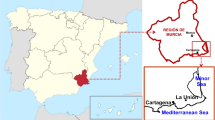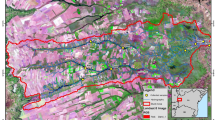Abstract
Increased concentrations of several trace elements have been observed in water draining areas with sulphidic sediments along the Baltic Sea coast of Sweden and Finland. Some of these elements are harmful to the water environment. The increased leaching of trace elements is often caused by antrophogenic activities, such as ditching, which cause oxidation of the sulphides and thereby acid soil conditions. It is therefore important to recognise areas with sulphidic sediments and, if possible, avoid land use, which causes sulphide oxidation. The aim of this study was to find time effective methods, which can be used to delineate areas with sulphidic sediments. Three areas in Sweden with known occurrences of sulphidic sediments were studied. Data obtained from the mapping program at the Geological Survey of Sweden (SGU) were first studied. Selected sites were thereafter visited and geoelectrical measurements were carried out by the use of several instruments. The results imply that areas with sulphidic sediments are reflected as areas with high trace element contents on SGUs biogeochemical maps, which are based on analyses of trace elements in aquatic plants. The same deposits are often shown as gyttja clay on the maps of Quaternary deposits. Furthermore models derived from airborne electromagnetic measurements show that areas with sulphidic sediments often have a lower electric resistivity than surrounding sediments. Also the results from ground geoelectrical measurements suggest that the sulphidic sediments have a lower resistivity than surrounding fine-grained deposits. That interpretation was verified after stratigraphical studies and analyses of the sulphur contents of the sediments. It is therefore suggested that data from ground geophysical measurements can be used for a detailed delineation of sulphidic sediments, whereas data obtained from airborne geophysical and geological maps give an overview over potential areas with these sediments. The absolute resistivity of the sulphidic sediments varies, however, between the three investigated areas. Complementary corings and stratigraphical descriptions are therefore always necessary to verify the occurrence of these sediments.









Similar content being viewed by others
References
Åström M (1996) Geochemistry, chemical reactivity and extent of leaching of sulphide-bearing fine-grained sediments in Southern Ostrobothnia, Western Finland. Ph.D., Department of Geology and Mineralogy, Åbo Akademi University, Åbo
Åström M (1998) Partitioning of transition metals in oxidised and reduced zones of sulphide-bearing fine-grained sediments. Appl Geochem 13:607–617
Åström M, Björklund A (1995) Impact of acid sulfate soils on stream water geochemistry in western Finland. J Geochem Explor 55:163–170
Åström M, Åström J (1997) Geochemistry of stream water in a catchment in Finland affected by sulphidic fine sediments. Geochem Explor Environ Anal 3:197–203
Åström M, Rönnback K (2005) Concentration levels and spatial distribution of sulphur and metals in fine-grained sediments in western Finland. Agric Food Sci 14:14–23
Åström M, Sundström R, Holmberg M, Storberg K-E (2005) pH of streams in western Finland—a perspective from Middle Ages into the mid 21st century. Agric Food Sci 14:5–13
Bastani M (2001) EnviroMT—a new controlled source/radio magnetotelluric system. Ph.D., Acta Universitatis Upsaliensis, Uppsala Dissertations from the faculty of Science and Technology, p 32
Becken M, Pedersen LB (2003) Transformation of VLF anomaly maps into apparent resistivity and phase. Geophysics 68:497–505
Björnbom S (1983) Description of the quaternary map Strängnäs NV. Geological Survey of Sweden Ae 60 (English summary)
Dahlin T (1996) 2D resistivity surveying for environmental and engineering applications. First Break 14:275–283
Eriksson J, Andersson A, Andersson R (1999) Texture of agricultural topsoils in Sweden. Swedish Environmental Protection Agency Report 4955 (English summary)
Fromm E (1965) Quaternary Deposits of the Southern Part of the Norrbotten County. Geological Survey of Sweden Ca 39 (English summary)
Georgala D (1980) Palaeoenvironmental studies of post-glacial black clays in north-eastern Sweden. Ph.D., Stockholm Contribution in geology, p 36
Granlund E (1943) Beskrivning till jordartskarta över Västerbottens län nedanför odlingsgränsen (Description for map of the Quaternary deposits of the country of Västerbotten). Geological Survey of Sweden Ca 26 (in Swedish)
Kuras O, Beamish D, Meldrum PI, Ogilvy RD (2006) Fundamentals of the capacitive resistivity technique. Geophysics 71:135–152
Lax K (2005) Stream plant chemistry as indictor of acid sulphate soils in Sweden. Agric Food Sci 14:83–87
Lax K, Selinus O (2005) Geochemical mapping at the Geological Survey of Sweden. Geochem Explor Environ Anal 5:337–346
Lax K, Sohlenius G (2006) Sura sulfatjordar och metallbelastning. (Metal load from acid sulphate soils) Geological Survey of Sweden Report 2006:5 (in Swedish)
Lintinen P, Suppala I, Vanhala H, Eklund M (2003) Survey of a buried ice-marginal deposit by airborne EM measurements—a case from Kyrönjoki valley plain in southern Osterbothnia, Finland. Geol Surv Finl Spec Pap 36:67–75
Loke MH (2004) Rapid 2-D resistivity & IP inversion using the least-squares method. Manual for Res2dinv, version 3.54, p 53 (available at www.geoelectrical.com)
McNeill JD, Labson VF (1990) Geological mapping using VLF radio fields. In: Nabighian MN (ed) Electromagnetic methods in applied geophysics, vol 2, part B. Society of Exploration Geophysicist, pp 521–640
Manngård B (1997) Sulfidhaltiga lerors inverkan på vattenkemin i två tillflöden till Sörfjärden, Mälaren (Impact of cultivated acid sulphate soils on surface water chemistry in two small catchments in the southern Mälaren region). Swedish University of Agricultural Sciences, Department of Soil Sciences, Section of soil chemistry and pedology, Examens- och seminariearbeten 28 (English summary)
Nystrand B-Å (1980) Some properties of sulphide-bearing sediments on the coast of northern Sweden. Ph.D., Department of Quaternary Geology, University of Uppsala, Striae 13
Öborn I (1989) Properties and classification of some acid sulfate soils in Sweden. Geoderma 45:197–219
Pedersen LB, Bastani M, Dynesius L (2005) Groundwater exploration using combined controlled-source and radiomagnetotelluric techniques. Geophysics 70:G8
Pedersen LB, Engels M (2005) Routine 2D inversion of magnetotelluric data using the determinant of the impedance tensor. Geophysics 70:G33–G41
Pedersen LB, Qian W, Dynesius L, Zhang P (1994) An airborne tensor VLF system. From concept to realisation. Geophys Prospecting 42:863–883
Puranen R, Mälilä M, Sulkanen K, Grundström A (1997) A new apparatus for electric conductivity and temperature logging of soft sediments. Geol Surv Finl Spec Pap 23:149–155
Siripunvaraporn W, Egbert G (2000) An efficient data-subspace inversion method for 2-D magnetotelluric data. Geophysics 65:791–803
Sohlenius G, Öborn I (2004) Geochemistry and partitioning of trace elements in acid sulphate soils in Sweden and Finland before and after sulphide oxidation. Geoderma 122:167–175
Sohlenius G, Persson L, Lax K, Andersson L, Daniels J (2004) Förekomsten av sulfidhaltiga postglacial sediment (The occurence of postglacial sulphidic sediments). Swedish Geological Survey, Report 2004:9 (in Swedish)
Suppala I, Lintinen P, Vanhala H (2005) Geophysical characterisation of sulphide rich fine-grained sediments in Seinäjoki area, western Finland. Geol Surv Finl Spec Pap 38:61–71
Svantesson S (1999) Description of the Quaternary map 7G Västervik SO/ 7H Loftahammar SV. Geological Survey of Sweden Ae 124 (English summary)
Vázquez MD, Fernández JA, López J, Carballeira A (2000) Effects of water acidity and metal concentration on accumulation and within-plant distribution of metals in the aquatic bryophyte Fontinalis antipyretica. Water Air Soil Pollut 120:1–20
Walker J, Houser PR (2002) Evaluation of the OhmMapper instrument for soil moisture measurement. Soil Sci Soc Am J 66:728–724
Ward SH (1990) Resistivity and Induced polarization methods. In: Investigations in geophysics No. 5, vol 1, Geotechnical and environmental geophysics, Society of Exploration Geophysics, pp 147–189
Wiklander L, Hallgren G (1949) Studies on gyttja soils. I. Distribution of different sulfur and phosphorus forms and of iron, manganese and calcium carbonate in a profile from Kungsängen. Ann R Agric Coll Swed 16:811–827
Wiklander L, Hallgren G, Brink N, Jonsson E (1950) Studies on gyttja soils. II. Some characteristics of two profiles from northern Sweden. Ann R Agric Coll of Swed 17:24–36
Yli-Halla M, Palko J (1987) Mineral element content of oats (Avena sativa L.) in an acid sulphate soil area of Tupos village, northern Finland. J Agric Food Sci Finl 59:73–78
Author information
Authors and Affiliations
Corresponding author
Appendix 1
Appendix 1
EnviroMT
The EnviroMT has been mainly developed at the Department of Earth Sciences of Uppsala University. The instrument uses RMT (RadioMagnetoTelluric) method. RMT is an electromagnetic method that makes use of the signal in the frequency range between 15 and 250kHz from long-distance radio transmitters. Two components of the electric field and three components of the magnetic field of the signals are measured at the same time. The ratio between the horizontal electric and the horizontal magnetic field components for each measuring frequency is directly related to the electrical resistivity of the ground. For a homogenous half space the resistivity, ρ, is given by
where f is the frequency, μ 0 the magnetic permeability of free space, E x the electric field component in x direction and H y the magnetic field component in y direction. x and y directions are dependent on the measuring coordinate system. X is usually in the magnetic north and y in the magnetic east direction. The signal at lower frequencies penetrates deeper into the ground and letting us to model the ground resistivity with depth.(The measured electric and magnetic fields at each frequency and station are transformed into the resistivity and phase. The measured values are then used to model the resistivity variations along and under the profile. The spacing for EnviroMT measurements was 10m along the profiles. The EnviroMT has been used in earlier studies dealing with the stratigraphical distribution of Quaternary deposits (Bastani 2001; Pedersen et al. 2005).
Lund imaging system
The ABEM Lund Imaging System (Dahlin 1996) is a multi-electrode resistivity system. In the dc resistivity method an electrical current is injected into the ground and the resulting potential distribution is measured. By altering the distances between the electrodes, information about resistivities on different depths is obtained. In the multi-electrode system a large number of steel electrode are placed along the profile and connected to multi-core cables with one take-out for each electrode. The systems use an electrode selector, a switching unit that is controlled by the computer to select the appropriate electrodes for each measurement.
A large number of electrodes (up to 64) were placed at the ground and the resistivity at different depth was then automatically measured along the profile. An electrode separation of 5m were used for all profiles.
OhmMapper
The Geometrics OhmMapper is a capacitively coupled resistivity meter that measures the electrical properties of the ground without the use of electrodes as in traditional resistivity surveys. This technique is based on the capacitive coupling mechanism between sensors and the ground, in contrast to resistivity techniques that are based either on galvanic coupling, e.g., dc resistivity or inductive coupling electromagnetic EM techniques (Kuras et al. 2006). The ground resistivity is continuously measured along profiles, which admits a fast collection of data. This instrument has proved to be useful for detailed mapping of the ground resistivity (Walker and Houser 2002). The data were acquired 4 times per second (ca. 25cm station spacing) that provided a high resolution along the profiles. The data used here contain measurements with four transmitter-receiver separation (2, 5, 10, and 20m).
Resistivity probe
The resistivity probe has an electrical sensor, which measures the resistivity in a soil volume with a radius of a few centimetres. The probe is manually pressed through the sediments. The resistivity were measured every 25cm and in some areas it was possible to reach a depth of more than 10m. The probe was developed by Puranen et al. (1997) at the Geological Survey of Finland (GTK) and has earlier been used to study the properties of sulphidic sediments (Suppala et al. 2005).
Rights and permissions
About this article
Cite this article
Sohlenius, G., Bastani, M., Persson, L. et al. On the recognition of areas with problematic sulphidic sediments using multi-disciplinary data. Environ Geol 56, 973–984 (2009). https://doi.org/10.1007/s00254-008-1199-y
Received:
Accepted:
Published:
Issue Date:
DOI: https://doi.org/10.1007/s00254-008-1199-y




